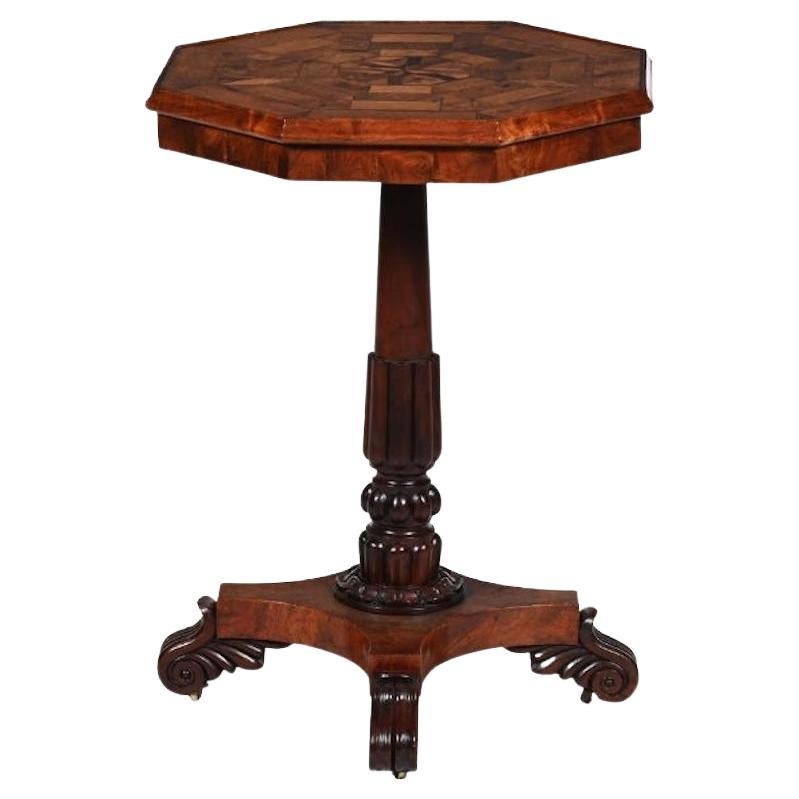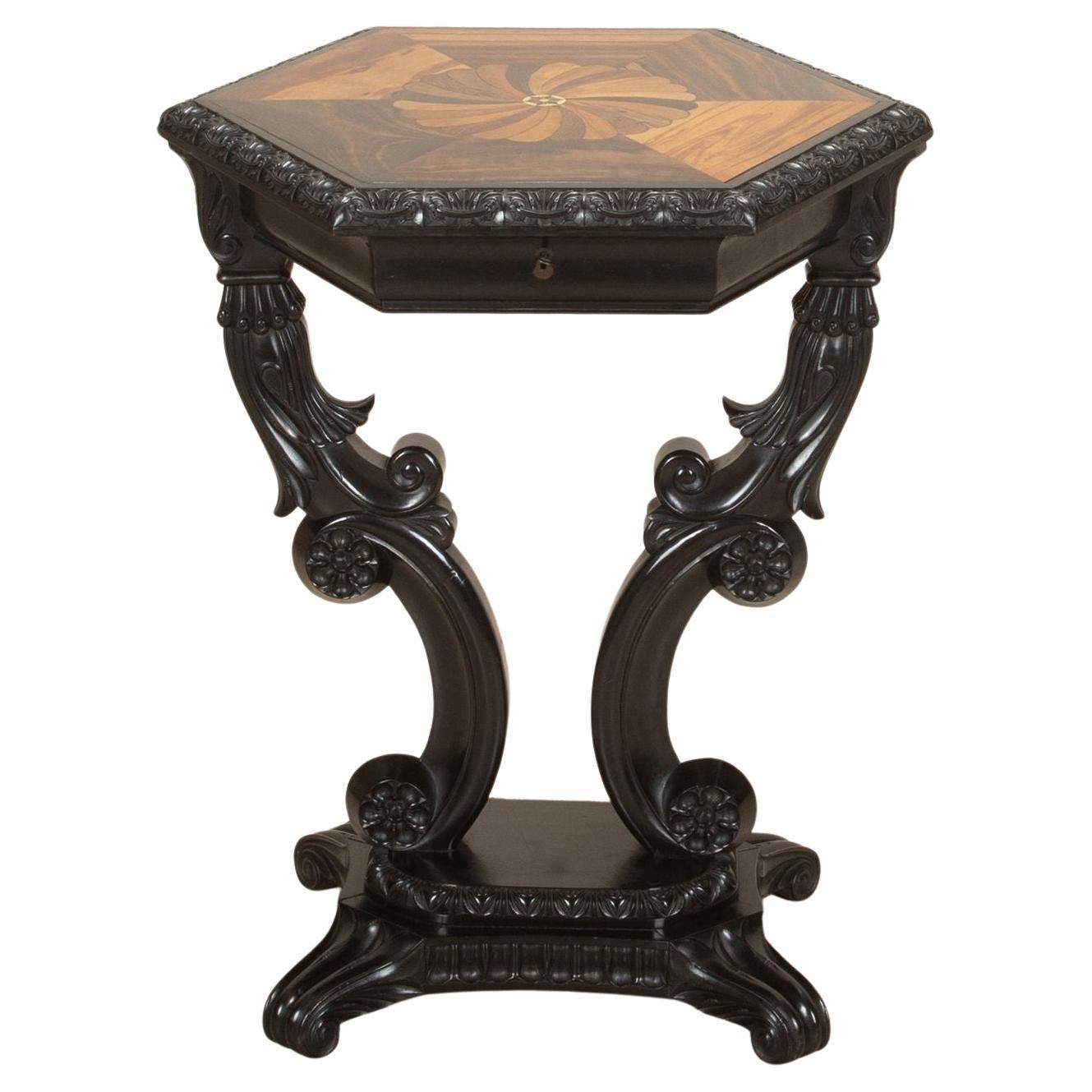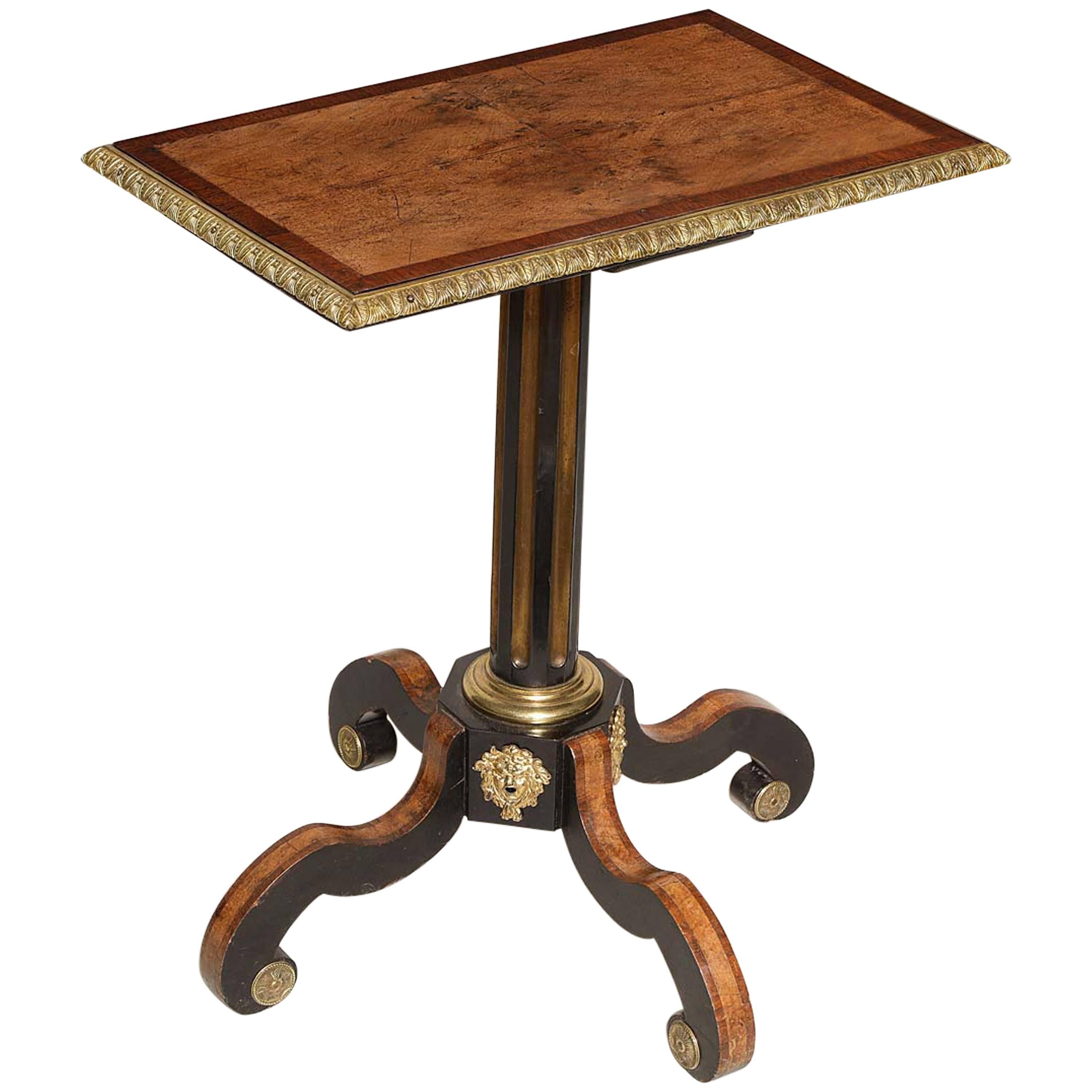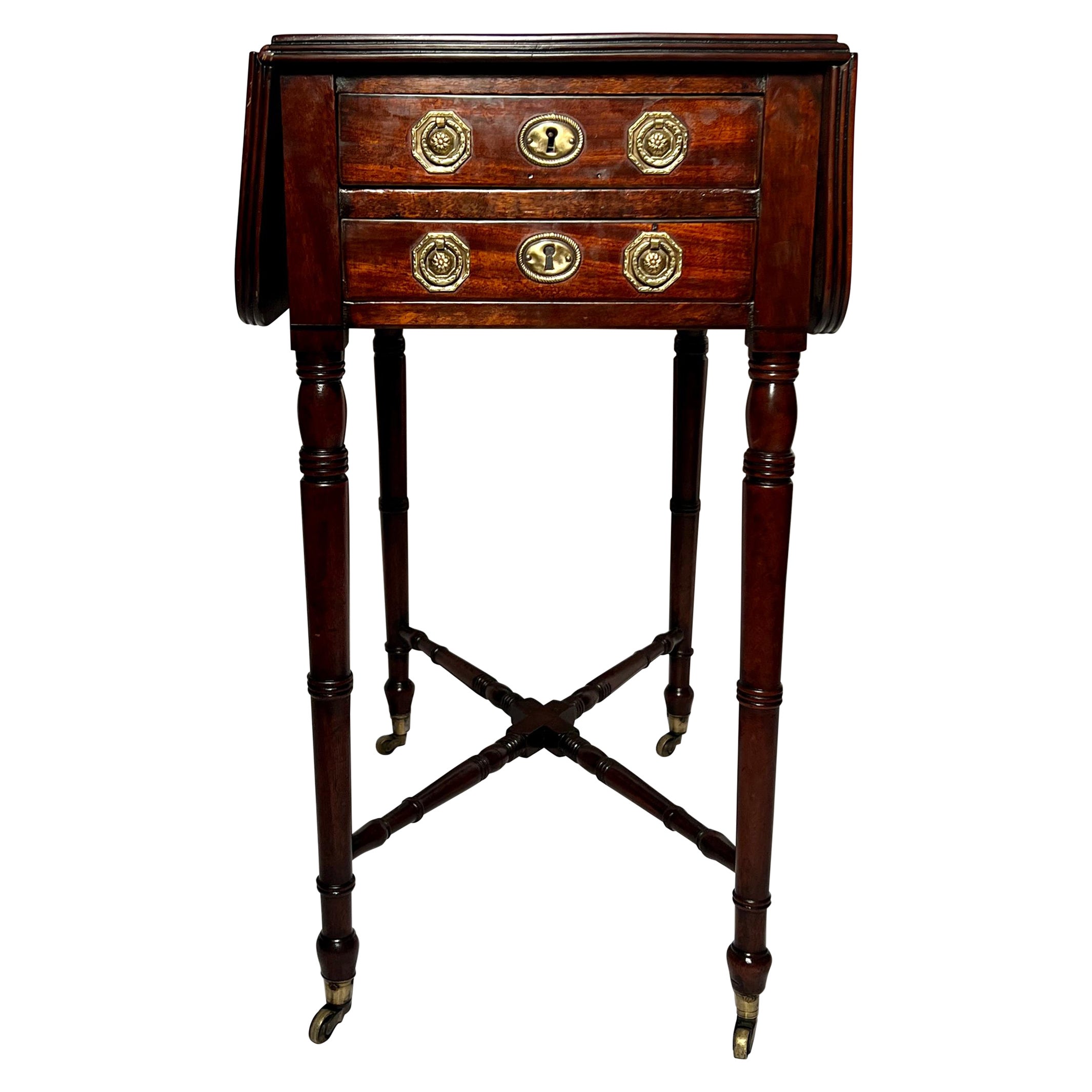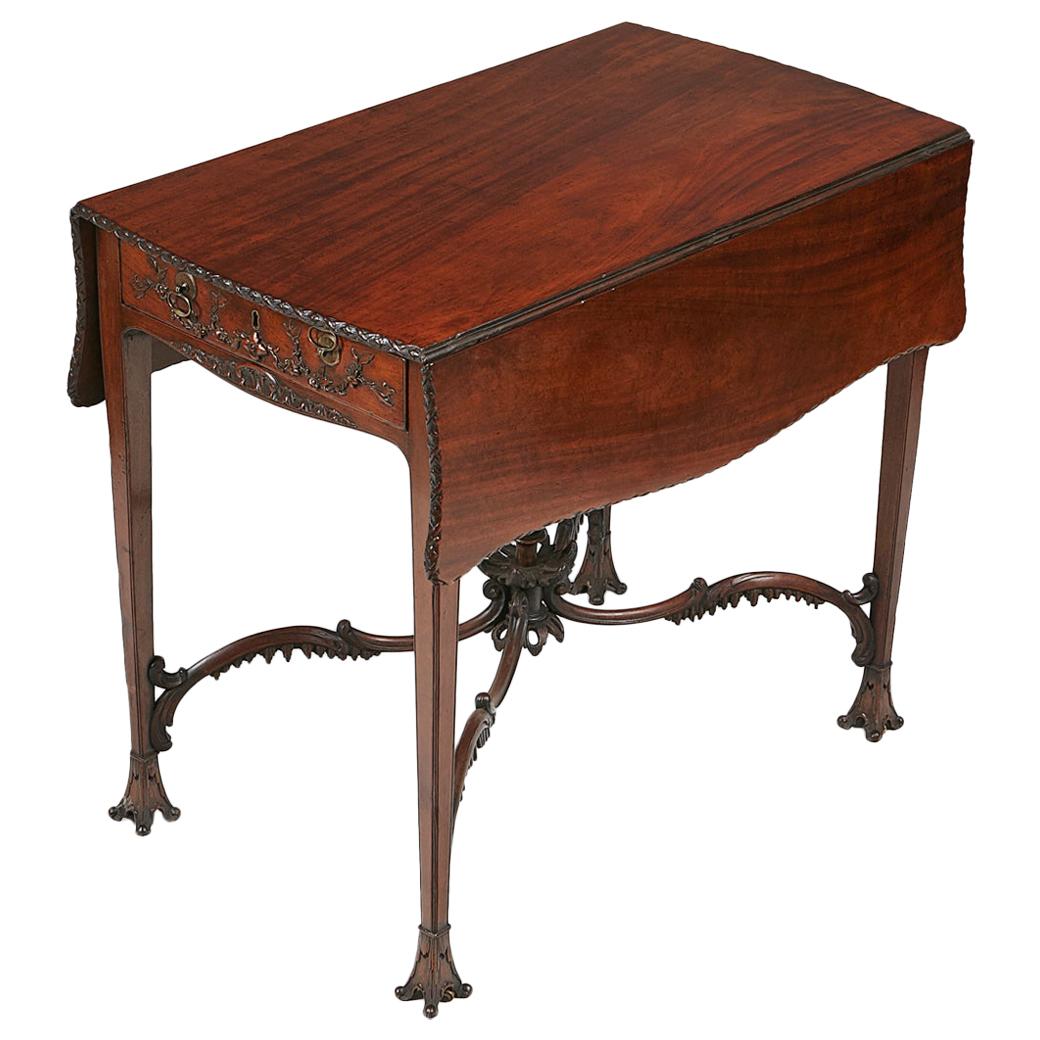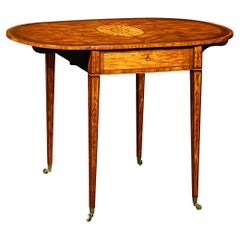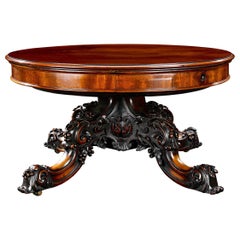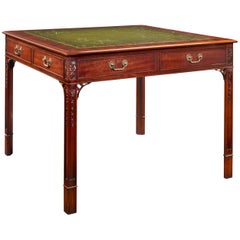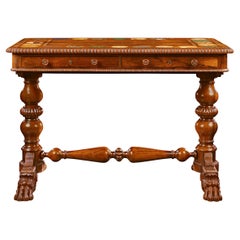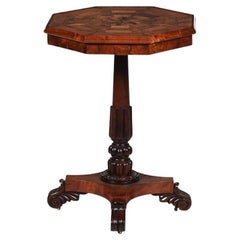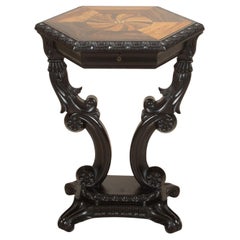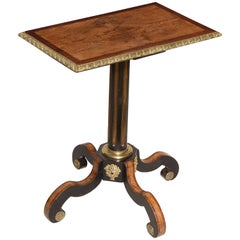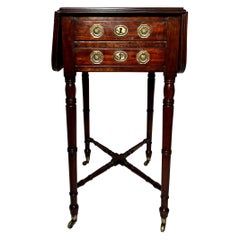Items Similar to Specimen Table Attributed to William Trotter
Want more images or videos?
Request additional images or videos from the seller
1 of 5
Specimen Table Attributed to William Trotter
$48,850
£36,942.29
€42,315.28
CA$68,450.59
A$74,725
CHF 39,343.65
MX$895,118.79
NOK 503,190.77
SEK 459,421.53
DKK 316,104.98
About the Item
Octagonal Specimen Table
William Trotter
Early 19th Century
This extraordinary early 19th-century Scottish specimen table is a museum-quality masterpiece attributed to William Trotter of Edinburgh, who is widely regarded as Scotland’s greatest cabinetmaker. The octagonal top is exquisitely inlaid with agate, jasper and rare Scottish hardstones, arranged in a striking pattern reminiscent of a stunning plume of feathers. The result is a remarkable fusion of geometric precision and the natural beauty of indigenous minerals. It is among the most important Scottish specimen tables ever made, and no other like it is known to exist.
A finely carved foliate border in richly figured rosewood frames the top, enhancing its ornamental elegance. The vibrant gemstones are fitted with precision, reflecting a masterful command of both materials and technique. The table is supported by a well-balanced base and remains in untouched “country house” condition, a rare and desirable state that speaks to its long history and impeccable provenance.
William Trotter (1772–1833) was the preeminent cabinetmaker of the Scottish Regency period and served as Lord Provost of Edinburgh from 1825 to 1827. He established his firm on Princes Street in 1805 and supplied furnishings to Scotland’s most distinguished estates, as well as to the Royal Collection. His work is instantly recognizable for its refined lines and commanding presence. This table stands among the finest examples of his output, combining superior craftsmanship with exceptional materials in a work of singular historical and artistic importance.
28 3/4" high x 20 1/2" wide x 16 1/2" deep
- Attributed to:William Trotter (Cabinetmaker)
- Dimensions:Height: 28.75 in (73.03 cm)Width: 20.5 in (52.07 cm)Depth: 16.5 in (41.91 cm)
- Style:Regency (Of the Period)
- Materials and Techniques:
- Place of Origin:
- Period:
- Date of Manufacture:19th Century
- Condition:
- Seller Location:New Orleans, LA
- Reference Number:Seller: 32-07771stDibs: LU891145333682
About the Seller
5.0
Recognized Seller
These prestigious sellers are industry leaders and represent the highest echelon for item quality and design.
Established in 1912
1stDibs seller since 2010
114 sales on 1stDibs
Typical response time: 4 hours
- ShippingRetrieving quote...Shipping from: New Orleans, LA
- Return Policy
More From This Seller
View AllGeorge III Pembroke Table attributed to Ince & Mayhew
By Ince & Mayhew
Located in New Orleans, LA
This extraordinary George III-period Pembroke table by London cabinetmakers Ince & Mayhew displays the understated sophistication of the late Georgian era. The surface of the table — including both the central panel and the signature Pembroke hinged flaps — is beautifully detailed with satinwood marquetry, inlaid with a fan medallion and foliate motifs executed with the greatest precision and craftsmanship. The table is set upon slender, tapering legs. The design is indicative of the rising influence of and interest in Neoclassical patterns, favoring motifs from nature or Classical antiquity over the extravagance of the Rococo style.
William Ince and John Mayhew joined their skills as furniture designers and cabinetmakers, opening a firm together on Broad Street in 1759. Over the next forty years, the duo would execute many commissions, and develop a volume of engraved designs entitled The Universal System...
Category
Antique 18th Century English Georgian Drop-leaf and Pembroke Tables
Materials
Satinwood
19th Century Exhibition Model of Expanding Table by Samuel Hawkins
By Samuel Hawkins
Located in New Orleans, LA
A masterpiece of both cabinetmaking and mechanical engineering, this one-of-a-kind expanding table was crafted by the renowned cabinetmaker Samuel Hawkins of London for the Great Exhibition of 1851. Diminutive in size, the fascinating table was designed as a model to demonstrate Hawkins’ innovative patent screw movement to visitors of the Exhibition – six million people in total over five months. It was exhibited again a century later at the Victoria & Albert Museum during the Festival of Britain, an event intended “to symbolise two main qualities of the national character: realism and strength on the one hand, and, on the other, independence and imagination” (Catalogue of the Exhibition, 1951, p.117). To this day, the miniature masterpiece demonstrates the quest of English furniture makers to combine technical innovation with superb craftsmanship.
Displaying exceptional ingenuity, Hawkins’ wind-out screw mechanism allowed one to extend the table’s base to accommodate concentric leaves with the simple crank of a handle. It is based on the inventive expanding table originally designed by Robert Jupe in 1835, which used a swivel mechanism to separate sections of the tabletop and allow for segmented leaves to be inserted. Hawkins’ tabletop, on the other hand, extends outwards directly from the center in order to accommodate additional leaves around its diameter. This unique design allowed the mechanism to also smoothly operate on rectangular tables, which could be wound out from the middle to allow for more table space.
Hawkins was not alone in his endeavor to combine the technical merits of engineering and mechanics with the most artful pursuit of cabinetmaking. The first half of the 19th century saw a prolific increase in the popularity of applying new ideas to traditional furniture principles, which allowed furniture to serve many purposes. The resulting “patent” furniture was practical and refined, though few were as innovative as Hawkins’ prodigious design.
Carved with the year of the Exhibition on the beautifully designed pedestal base, the table is a testament to the significance of this innovation. The model is mentioned in detail in the catalog of the Great Exhibition of 1851, the first international exhibition of industry, manufacturing, and science. Held at London’s dazzling Crystal Palace, its visitors were treated to exhibits from around the globe, including feats of engineering, innovations in industry, and marvels of design. Queen Victoria herself was a frequent visitor, along with her husband, Prince Albert, and others including Charlotte...
Category
Antique 19th Century English Other Tables
Materials
Mahogany
Regency Library Table
Located in New Orleans, LA
This handsome Regency library desk is crafted of rich mahogany and features the straightforward design prevalent in England during the early 19th ...
Category
Antique Early 19th Century English Regency Desks and Writing Tables
Materials
Leather, Mahogany
$14,500
Hardstone and Rosewood Centre Table Attributed to Gillows
By Gillows of Lancaster & London
Located in New Orleans, LA
This remarkable rosewood centre table attributed to legendary firm Gillows showcases masterful craftsmanship and stunningly rare hardstone specimens. The table's base is ornately crafted, complete with lion's paw feet, emphasizing the quality of the wood. The most impressive element of this beautiful piece of furniture, however, is the exquisite inlaid table top. Featuring eighteen semi-precious and hardstone specimens artfully arranged in alternating geometric shapes, rare stones like gem quality Lapis Lazuli, Egyptian porphyry and Siberian amethyst dazzle the eye. Other stones and specimens inlaid in square, circle and hexagon shapes include pyrite lapis lazuli, malachite, green aventurine, agate of amethyst, greek spartan porphyry, labradorite, fossilized wood, occhio di pavone, brèche verte d'égypte, sicilian jaspers, blood stone, spanish brocatelle, siena brocatelle, convent siena and nero antico. The sheer variety and superb quality of these features is an overwhelming visual delight and a triumph of craftsmanship.
Hardstone pieces such as this were popular among the British aristocracy...
Category
Antique 19th Century Regency Center Tables
Materials
Agate, Amethyst, Lapis Lazuli, Malachite, Porphyry
Regency-Era Card Table
Located in New Orleans, LA
This ingenious late Regency card table was designed with both beauty and entertainment in mind. When not in use, its folded D-shaped top sits against the wall providing an elegant si...
Category
Antique Early 19th Century English Regency Game Tables
Materials
Wood
$8,850
19th Century Rosewood and Pietra Paesina Specimen Table Attributed
By Gillows of Lancaster & London
Located in New Orleans, LA
Pietra Paesina is one of the most scarce and wondrous stones on earth, and the surface of this exceptional early 19th-century center table is inset with...
Category
Antique Early 19th Century English Regency Center Tables
Materials
Marble
You May Also Like
19th Century Specimen Wood Top Occasional Table
Located in Bedfordshire, GB
A Rare 19th Century, William IV Period Occasional Table, Having Charming Octagonal Galleried Top, With Various Specimen Wood Veneers Inlaid To Unusual Pattern Design, Raised On Solid...
Category
Antique Mid-19th Century English William IV End Tables
Materials
Yew, Amboyna
Early 19th Century Specimen Occasional table
Located in Gloucestershire, GB
A smart early 19th Century Ceylonese ebony occasional table. The specimen inlaid hexagonal top centred by a swirl of exotic woods including palm, satinwood, coromandel and palisander...
Category
Antique Early 19th Century Indian British Colonial Card Tables and Tea T...
Materials
Ebony, Sandalwood, Satinwood
English Regency Table in the Manner of Thomas Parker
By Thomas Parker
Located in Greenwich, CT
English early 19th century occasional table with ormolu mounts in walnut, rosewood and ebony veneer. The rectangular top with quarter veneered center in walnut, banded in rosewood, the edges trimmed in acanthus molded bronze on center shaft, the flutes edged in gilt brass, standing on four legs in the Louis XIV manner. Again having gilt bronze mounts.
Thomas Parker...
Category
Antique 1810s English Regency End Tables
Materials
Bronze
Antique English William IV Pembroke Table
Located in New Orleans, LA
Antique English William IV Pembroke Table
Open to 26 inches
Category
Antique Late 19th Century English Drop-leaf and Pembroke Tables
Materials
Mahogany
18th Century Pembroke Table after Chippendale
Located in Dublin 8, IE
18th century mahogany pembroke table in the style of Chippendale, the shaped butterfly top with fret moulded edges raised over single drawer with brass pulls, carved bellflower and f...
Category
Antique 18th Century Irish Chippendale Drop-leaf and Pembroke Tables
Materials
Mahogany
Regency Palisander Diminutive Pembroke Table
Located in Essex, MA
Rectangular top with rectangular drop leaves over a frieze drawer, raised on square tapered legs and casters.
Category
Antique Early 1800s English Regency Drop-leaf and Pembroke Tables
Materials
Palisander
More Ways To Browse
Antique Scottish Agate
Scottish Regency
Kazuhide Takahama For Cassina
La Fenice
Mahogany Campaign Desks
Mohair Bed
Mosaic Plate
Odd Fellows
Pair Of Etchings
Pig Folk Art
Resin Elephant
Seguso Murano Amber Glass
Sevres Porcelain Cabinet
Sevres Style Porcelain Three Piece
Swiss Army
Tapio Wirkkala Studio
Terracotta Oil Jars
Thuya Wood
